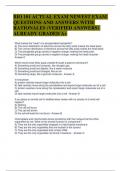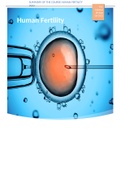BIO 101 ACTUAL EXAM NEWEST EXAM
QUESTIONS AND ANSWERS WITH
RATIONALES (VERIFIED ANSWERS)
ALREADY GRADED A+
What makes the "head" of a phospholipid hydrophilic?
A) The even distribution of electrons across the fatty acids makes the head polar.
B) The uneven distribution of electrons across the fatty acids makes the head polar.
C) The phosphate group carries a negative charge, making the head polar.
D) The phosphate group carries a negative charge, making the head nonpolar -
Answer-C
Which would most likely pass unaided through a plasma membrane?
A) Something small and nonpolar, like nitrogen gas
B) Something small and dipolar, like a water molecule
C) Something small and charged, like an ion
D) Something large, like a glucose molecule - Answer-A
In exocytosis
A) protein vesicles import large molecules into a cell.
B) lipid vesicles move along the cytoskeleton and export large molecules out of a cell.
C) protein vesicles move along the cytoskeleton and export large molecules out of a
cell.
D) lipid vesicles import large molecules into a cell - Answer-B
If you place an animal cell in distilled water (water with no solutes in it) what will
happen?
A) Nothing
B) The cell will burst
C) The cell will shrink
D) the cell will swell but not burst - Answer-B
Chloroplasts and mitochondria share something with the nucleus that the other
organelles do not. What is this shared function or component?
A) They are the only organelles wrapped in a lipid-based membrane.
B) They are the only organelles that are located in the cytosol.
C) They are the only organelles that contain DNA.
D) They are the only organelles not found in bacteria. - Answer-C
, A protein that will be transported to the plasma membrane will travel the following path
A) ribosome, endoplasmic reticulum, vesicle, golgi apparatus, vesicle, plasma
membrane
B) ribosome, smooth endoplasmic reticulum, golgi apparatus, vesicle, plasma
membrane
C) endoplasmic reticulum, ribosome, golgi apparatus, vesicle, plasma membrane
D) nucleus, vesicle,endoplasmic reticulum, vesicle, golgi apparatus, vesicle, plasma
Membrane - Answer-A
Implanting pig extracellular matrix in a damaged human thigh can help muscle tissue
regrow.
True
False - Answer-True
Non-functional cilia can result in many different problems including kidney damage.
True False - Answer-True
Energy can be but not . Chemicals the biosphere but
energy the biosphere.
A) converted, destroyed, flow through, is recycled in
B) converted, destroyed, are recycled in, flows through
C) destroyed, converted, flow through, is recycled in
D) destroyed, converted, are recycled in, flows through - Answer-B
Which of the following is a waste product of photosynthesis?
A) CO2
B) H2O
C) O2
D) All of these - Answer-C
How does CO2 enter a plant?
A) Through the roots
B) Through the stroma
C) Through the stomata
D) Through the grana - Answer-C
Organize the following steps of the light reaction in order.
A) Absorb sunlight, produce high-energy electron carriers, produce oxygen, split water
B) Absorb sunlight, produce high-energy electron carriers, split water, produce oxygen
C) Absorb sunlight, split water, produce oxygen, produce high-energy electron carriers
D) Absorb sunlight, produce oxygen, split water, produce high-energy electron carriers -
Answer-C
If the light reactions proceeded but the Calvin cycle didn't, then molecules
would accumulate and molecules would not be made.





